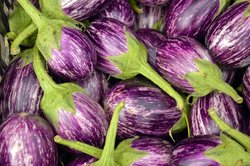Eggplant
|
|
| Eggplant | ||||||||||||||||
|---|---|---|---|---|---|---|---|---|---|---|---|---|---|---|---|---|
 white eggplant | ||||||||||||||||
| Scientific classification | ||||||||||||||||
| ||||||||||||||||
| Binomial name | ||||||||||||||||
|
Solanum esculentum |
An eggplant, brinjal or aubergine is either of two species of nightshade, Solanum melongena and S. esculentum, bearing large pendulous purple or white fruit. The raw fruit has a spongelike texture and somewhat disagreeable taste, but on cooking becomes tender and develops a rich, complex flavor. It is especially useful culinarily owing to its ability to absorb great amounts of cooking fats, making possible extraordinarily rich dishes.
The variety that closely resembles a chicken egg in both size and shape is commonly known today as Indian eggplant. The varieties cultivated in The West today are of similar shape but both larger and darker. Chinese eggplant is shaped like a cucumber. Both Indian and Chinese eggplant usually have a color gradient, from white at the stem to bright purple to deep purple, but albino varieties also exist.
Although aubergine is the (British) English name given to this fruit, it is often invoked to describe other objects with a dark plum-color. This name comes from the French aubergine.
The word melongena is from the Sanskrit vatinganah, which has produced a number of names for this plant in various languages: brinjal, badingan, melongena, melenzana, berenjena, aubergine, brown-jolly, and mad-apple (misinterpretation of Italian melanzana as mela insana).
See also
- Baba ganoush
- Caviar d'aubergine (French Provencal Cuisine)
- Escalivada (Catalan cuisine)
- Moussaka (Greek cuisine)
- Mutabal (Lebanese cuisine)
- Thai eggplant


